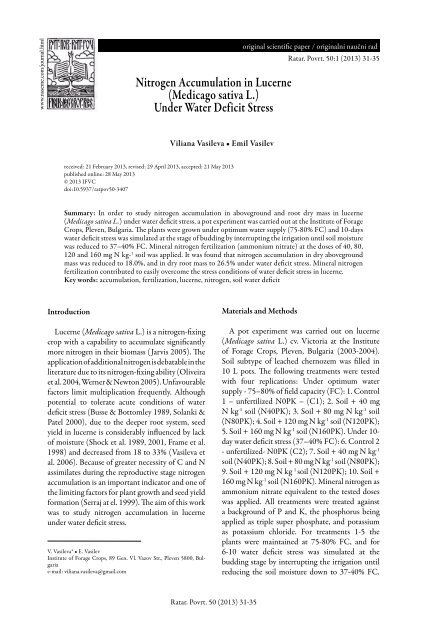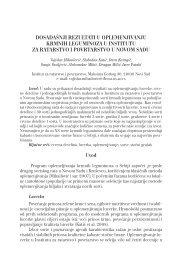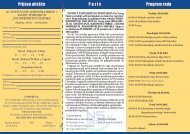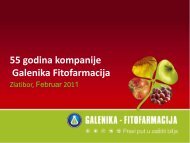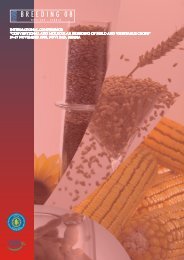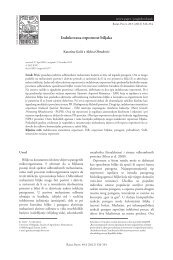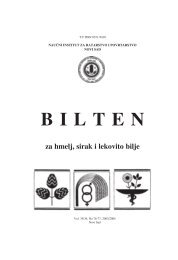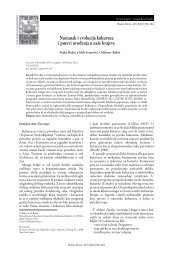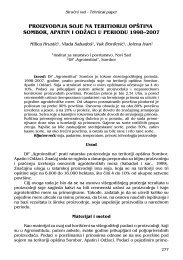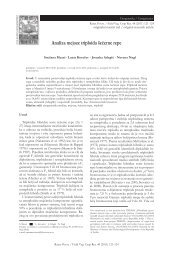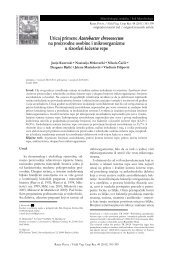Nitrogen Accumulation in Lucerne (Medicago sativa L ... - NS seme
Nitrogen Accumulation in Lucerne (Medicago sativa L ... - NS seme
Nitrogen Accumulation in Lucerne (Medicago sativa L ... - NS seme
You also want an ePaper? Increase the reach of your titles
YUMPU automatically turns print PDFs into web optimized ePapers that Google loves.
www.ns<strong>seme</strong>.com/journal.html<strong>Nitrogen</strong> <strong>Accumulation</strong> <strong>in</strong> <strong>Lucerne</strong> under Water Deficit 31orig<strong>in</strong>al scientific paper / orig<strong>in</strong>alni naučni rad<strong>Nitrogen</strong> <strong>Accumulation</strong> <strong>in</strong> <strong>Lucerne</strong>(<strong>Medicago</strong> <strong>sativa</strong> L.)Under Water Deficit StressRatar. Povrt. 50:1 (2013) 31-35Viliana Vasileva • Emil Vasilevreceived: 21 February 2013, revised: 29 April 2013, accepted: 21 May 2013published onl<strong>in</strong>e: 28 May 2013© 2013 IFVCdoi:10.5937/ratpov50-3407Summary: In order to study nitrogen accumulation <strong>in</strong> aboveground and root dry mass <strong>in</strong> lucerne(<strong>Medicago</strong> <strong>sativa</strong> L.) under water deficit stress, a pot experiment was carried out at the Institute of ForageCrops, Pleven, Bulgaria. The plants were grown under optimum water supply (75-80% FC) and 10-dayswater deficit stress was simulated at the stage of budd<strong>in</strong>g by <strong>in</strong>terrupt<strong>in</strong>g the irrigation until soil moisturewas reduced to 37–40% FC. M<strong>in</strong>eral nitrogen fertilization (ammonium nitrate) at the doses of 40, 80,120 and 160 mg N kg- 1 soil was applied. It was found that nitrogen accumulation <strong>in</strong> dry abovegroundmass was reduced to 18.0%, and <strong>in</strong> dry root mass to 26.5% under water deficit stress. M<strong>in</strong>eral nitrogenfertilization contributed to easily overcome the stress conditions of water deficit stress <strong>in</strong> lucerne.Key words: accumulation, fertilization, lucerne, nitrogen, soil water deficitIntroduction<strong>Lucerne</strong> (<strong>Medicago</strong> <strong>sativa</strong> L.) is a nitrogen-fix<strong>in</strong>gcrop with a capability to accumulate significantlymore nitrogen <strong>in</strong> their biomass ( Jarvis 2005). Theapplication of additional nitrogen is debatable <strong>in</strong> theliterature due to its nitrogen-fix<strong>in</strong>g ability (Oliveiraet al. 2004, Werner & Newton 2005). Unfavourablefactors limit multiplication frequently. Althoughpotential to tolerate acute conditions of waterdeficit stress (Busse & Bottomley 1989, Solanki &Patel 2000), due to the deeper root system, seedyield <strong>in</strong> lucerne is considerably <strong>in</strong>fluenced by lackof moisture (Shock et al. 1989, 2001, Frame et al.1998) and decreased from 18 to 33% (Vasileva etal. 2006). Because of greater necessity of C and Nassimilates dur<strong>in</strong>g the reproductive stage nitrogenaccumulation is an important <strong>in</strong>dicator and one ofthe limit<strong>in</strong>g factors for plant growth and seed yieldformation (Serraj at el. 1999). The aim of this workwas to study nitrogen accumulation <strong>in</strong> lucerneunder water deficit stress.V. Vasileva* • E. VasilevInstitute of Forage Crops, 89 Gen. Vl. Vazov Str., Pleven 5800, Bulgariae-mail: viliana.vasileva@gmail.comMaterials and MethodsA pot experiment was carried out on lucerne(<strong>Medicago</strong> <strong>sativa</strong> L.) cv. Victoria at the Instituteof Forage Crops, Pleven, Bulgaria (2003-2004).Soil subtype of leached chernozem was filled <strong>in</strong>10 L pots. The follow<strong>in</strong>g treatments were testedwith four replications: Under optimum watersupply - 75–80% of field capacity (FC): 1. Control1 – unfertilized N0PK – (C1); 2. Soil + 40 mgN kg -1 soil (N40PK); 3. Soil + 80 mg N kg -1 soil(N80PK); 4. Soil + 120 mg N kg -1 soil (N120PK);5. Soil + 160 mg N kg -1 soil (N160PK). Under 10-day water deficit stress (37–40% FC): 6. Control 2- unfertilized- N0PK (C2); 7. Soil + 40 mg N kg -1soil (N40PK); 8. Soil + 80 mg N kg -1 soil (N80PK);9. Soil + 120 mg N kg 1 soil (N120PK); 10. Soil +160 mg N kg -1 soil (N160PK). M<strong>in</strong>eral nitrogen asammonium nitrate equivalent to the tested doseswas applied. All treatments were treated aga<strong>in</strong>sta background of P and K, the phosphorus be<strong>in</strong>gapplied as triple super phosphate, and potassiumas potassium chloride. For treatments 1-5 theplants were ma<strong>in</strong>ta<strong>in</strong>ed at 75-80% FC, аnd for6-10 water deficit stress was simulated at thebudd<strong>in</strong>g stage by <strong>in</strong>terrupt<strong>in</strong>g the irrigation untilreduc<strong>in</strong>g the soil moisture down to 37-40% FC.Ratar. Povrt. 50 (2013) 31-35
34Table 3. Percent of reduction <strong>in</strong> nitrogen <strong>in</strong> dry mass yield <strong>in</strong> lucerne after water deficit stressVasileva V & Vasilev ETreatments <strong>Nitrogen</strong> <strong>in</strong> yield (%)Abovegrounddry massRootdry massTotal (aboveground + rootdry mass)N0PK(C1) 5.5 23.3 12.2N40PK 13.9 26.5 18.5N80PK 11.3 13.0 11.9N120PK 18.0 16.0 18.5N160PK 13.4 18.2 14.6deficit stress <strong>in</strong> terms of nodulation and dryroot mass (Vasileva 2010). Water deficit stressreduced total nitrogen accumulation (N <strong>in</strong>dry aboveground +N <strong>in</strong> dry root mass). Thisdecrease was lowest (11.9%) <strong>in</strong> treatmentsubjected to 80 mg N kg -1 soil.ConclusionsWater deficit stress decreased nitrogen <strong>in</strong> dryaboveground mass to 18.0% and nitrogen <strong>in</strong> dryroot mass to 26.5%. M<strong>in</strong>eral nitrogen fertilizationat a dose of 80 mg N kg -1 soil contributed to easilyovercome the stress conditions of water deficit <strong>in</strong>lucerne.ReferencesAntol<strong>in</strong>, M., Yoller, J., & Sanchez-Diaz, M. (1995). Effectsof temporary drought on nitrate-fed andnitrogen-fix<strong>in</strong>g alfalfa plants. Plant Science, 107,159-165.Busse, M. D., & Bottomley, P. J. (1989). Growth and nodulationresponses of Rhizobium meliloti to waterstress <strong>in</strong>duced by permeat<strong>in</strong>g and non-permeat<strong>in</strong>gsolutes. Applied and Environmental Microbiology, 55,2431-2436.Cihacek, L.J. (1994). Alfalfa nutrient needs and fertilization.In: Workshop Sobre O Potencial Forrageiro DaAlfafa (<strong>Medicago</strong> <strong>sativa</strong> L.) Nos Trópicos, Juiz de Fora,Anais. Juiz de Fora: EMBRAPA, CNPGL, 93-97.Frame, J. J., Charlton, J. F., & Laidlow, A. S. (1998). TemperateForage Legumes. CAB International, pp. 107-159.Hartwig, U. A., & Soussana, J. F. (2001). Ecophisiologyof symbiotic N 2fixation <strong>in</strong> grassland legumes. InJ. Isselste<strong>in</strong>, G. Spatz, M. Hofmann (eds.). OrganicGrassland Farm<strong>in</strong>g. Grassland Science <strong>in</strong> Europe6: 23-26.Humphries, A., & Auricht G. (2001). Breed<strong>in</strong>g lucernefor Australia’s southern dryland cropp<strong>in</strong>g environments.Australian Journal Agricultural Research52:153-169.Jarvis, S. C. (2005). N flow and N efficiency <strong>in</strong> legumesbased systems: a system overview. In Sward dynamics,N-flows and Forage Utilization <strong>in</strong> Legume-BasedSystems, Proc. of the 2 nd COST 852 workshop,Grado, Italy 10-12 November 2005, WachendorfM., Helgadottir A., Parente G. (eds.), 187-198.Nelson, D.W., & Sommers, L. E. (1980). Determ<strong>in</strong>ationof total nitrogen <strong>in</strong> plant material. Agronomy Journal,65, 109-112.Oliveira, W., Oliveira, P., Corsi, M., Duarte, F., & Tsai,S. M. (2004). Alfalfa yield and quality as functionof nitrogen fertilization and symbiosis with S<strong>in</strong>orhizobiummeliloti. Scientia Agricola (Piracicaba, Braz.),61, 433-438.Petkova, D. (1994). Effect of the fertilization with nitrogenand some microelements on the productivitydur<strong>in</strong>g the first year of alfalfa grown for seeds.Plant Science, 31(5-6), 33-37. (In Bg)Radeva, V. (1991). Biological reaction of lucerne varietiesunder the conditions of different water and nutritiveregime. Proceed<strong>in</strong>gs of the Eucarpia, September11-13, Kompolt, Hungary, 256-269.Serraj, R., S<strong>in</strong>clair, T., & Purcell, L. (1999). Symbiotic N 2fixation response to drought. Journal of ExperimentalBotany, 50, 143-155.Shock, C.C., Feibert, E. Pettet, F., Sadowski, A., & Saunders,M. (2001). Relationship between water stress andseed yield of two drip-irrigated alfalfa varieties. OregonState University Agricultural Experiment Station,Special Report 1038, 27-38.Shock, C.C., Stephen, W.P., Cairo, V., Stieber, T.D., &Saunders, M. (1989). Irrigation, <strong>in</strong>sect population, anddisease management for alfalfa seed production. OregonState University Agricultural Experiment Station,Special Report 844, 16-21.Ratar. Povrt. 50 (2013) 31-35
<strong>Nitrogen</strong> <strong>Accumulation</strong> <strong>in</strong> <strong>Lucerne</strong> under Water Deficit 35Solanki, R.M., & Patel, R.G, (2000). Response of lucerneto different moisture regimes. Phosphate levelsand sow<strong>in</strong>g methods. Indian Journal Agricultural Research,34, 160-163.Tufenkci, S., Erman, M., & Sonmez, F. (2006). Effect ofnitrogen application and Rhizobium <strong>in</strong>oculation onthe yield and nutrient uptake <strong>in</strong> lucerne (<strong>Medicago</strong> <strong>sativa</strong>).Bullet<strong>in</strong> of Pure and Applied Sciences-Botany, 25, 1.Vasileva, V. (2010). Effect of m<strong>in</strong>eral nitrogen fertiliz<strong>in</strong>gon nodulation of lucerne for seeds <strong>in</strong> conditionsof water deficiency stress. Journal of Mounta<strong>in</strong> Agricultureon the Balkans, 4, 950-960.Vasileva, V., Kostov, O., & Vasilev, E. (2006). Developmentof lucerne (<strong>Medicago</strong> <strong>sativa</strong> L.) treated withm<strong>in</strong>eral fertilizer and manure at optimal and waterdeficit conditions. Comm. Appl. Biol. Sci. Ghent University,4, 5-17.Werner, D., & Newton, W.E. (2005). Soil stress factors<strong>in</strong>fluenc<strong>in</strong>g symbiotic nitrogen fixation. In: <strong>Nitrogen</strong>Fixation <strong>in</strong> Agriculture, Forestry, Ecology, and theEnvironment. Series: <strong>Nitrogen</strong> Fixation: Orig<strong>in</strong>s,Applications, and Research Progress. Spr<strong>in</strong>ger, pp.89-102.Zahran, H. H. (1999). Rhizobium-legume symbiosis andnitrogen fixation under severe conditions and <strong>in</strong>an arid climate. Microbiology Molecular Biology Review,63, 968-989.Zahran, H. H. (2001). Rhizobia from wild legumes: diversity,taxonomy, ecology, nitrogen fixation andbiotechnology. Journal of Biotechnology, 91, 143-153.Akumulacija azota u lucerki (<strong>Medicago</strong> <strong>sativa</strong> L.)pri vodnom deficituViliana Vasileva • Emil VasilevIzvod: U cilju ispitivanja akumulacije azota u suvoj masi nadzemnih i podzemnih delova lucerke (<strong>Medicago</strong> <strong>sativa</strong>L.) pri vodnom deficitu, eksperiment u saksijama je izveden u Institutu za krmno bilje u Plevenu, Bugarska. Biljkesu uzgajane pod optimalnom obezbeđenošću vodom (75-80% poljskog vodnog kapaciteta), a desetodnevni stress privodnom deficit je simuliran u fazi pupoljaka prekidom dovoda navodnjavanja do smanjenja vlažnosti zemljišta na 37-40% vodnog kapaciteta. Primenjeno je m<strong>in</strong>eralno azotno đubrenje (amonijum nitrat) u dozama 40, 80, 120 i 160 mg Nkg-1 zemljišta. Akumulacija azota pri vodnom deficitu u suvoj masi nadzemnih delova je smanjena na 18,0% a u suvojmasi podzemnih delova na 26,5%. M<strong>in</strong>eralno azotno đubrenje dopr<strong>in</strong>elo je lakšem prevazilaženju stresnih uslova privodnom deficitu u usevu lucerke.Ključne reči: akumulacija, azot, deficit vode, đubrenje, lucerkaRatar. Povrt. 50 (2013) 31-35


